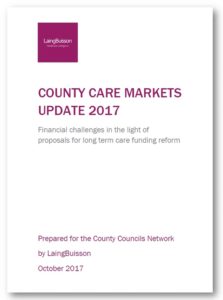
CCN Latest News, CCN News 2017 | 17 October 2017

The independent report by LaingBuisson, commissioned by the County Councils Network (CCN), shows that people who pay for their own care, ‘self-funders’, are paying weekly fees almost 50% higher than councils, due to cuts in local authority funding and rising demand for services. LaingBuisson shows that private fee payers are filling a gap of £670m per year in England’s counties.
 The report was covered in The Guardian today.
The report was covered in The Guardian today.
In recent years, care home providers have seen their profit margins dipping very low. If this continues, many will scale back or close, hitting the amount of beds and nurses available, with knock-on effects for councils and the wider NHS.
CCN says the report makes a clear argument that the Chancellor must immediately address funding pressures in adult social care during next month’s Autumn Budget and prioritise the publication of the long trailed Social Care Green paper, after speculation that it may not be released until next summer.
Shire County Authorities face an additional £1.6bn of cost pressures in adult social care by 2020/21, on top of the £670m market pressures. CCN has urged Ministers to carefully consider the findings of LaingBuisson’s research and ensure reforms are not “kicked into the long grass”.
Government has recently written to some councils outlining that they could withhold social care funding for those councils unless they meet new targets to reduce ‘bed-blocking’. Councils have previously called these imposed targets ‘completely unrealistic and counterproductive’.
They argue that while councils are using the first instalment of a £2bn social care fund announced in March to invest in care packages, increase care home fees, and reform local services, they argue that this research provides further evidence that this is insufficient to ‘fix’ the system and intervention by Ministers could make the situation worse.
LaingBuisson also analysed the impact local government reorganisation would have on care markets. The research of current bed capacity shows that sub-county unitary authorities lose the economies of scale in service commissioning and cross-subsidy between private and state fee payers, ‘locking in’ areas of high and low capacity, ‘potentially exacerbating underlying weaknesses’ in care markets in some areas and increasing market complexity.
The findings also show that the scale provided by county authorities allow them to better balance supply and demand when commissioning social care. Sub-county structures could limit the ability of commissioning authorities to pursue ‘sustainable’ market-management policies and balance supply and demand, the report warns.
The report also warns of the potential costs and ‘uneven distribution’ of the Conservative manifesto’s proposals to limit massive care costs individuals can face for elderly care. It suggests that unless fully funded, it could inadvertently push more care homes to close due to the funding gap.
During the Election campaign, the Government outlined controversial proposals for a ‘single threshold’, meaning no care user would be left with less than £100,000 in assets.
The report found that the introduction of the threshold could result in an annual cost of £308m for the 37 counties in England, because many more private fee payers would come into state support.
For councils in the Midlands and North, the threshold would take many private fee payers into state support – as many of 56% in one county – increasing the financial pressures facing providers in these areas as private fees are currently keeping them afloat, subsidising the lower council fees.
In addition, the report also analysed a cap on care, which the Conservatives say will not be implemented until after 2020 at the earliest. The introduction of a cap on care, introduced at the originally-proposed level of £72,000 could result in an annual cost rising to £330m for the 37 counties.
 Cllr Colin Noble, CCN Spokesman for Health & Social Care said;
Cllr Colin Noble, CCN Spokesman for Health & Social Care said;
“The social care market is broken. Substantial reductions to social care budgets have left councils with little choice but to negotiate lower fees for their taxpayers’ money, but this means the system is being propped up by private fee payers. This is clearly unsustainable, with many care home providers at a very real risk of collapse.
“This report demonstrates the acute pressures facing care markets across England and the complexity of implementing reforms that do not simply pile further pressure on local care providers. Whilst well intentioned, they could inadvertently push care homes closer to financial crisis.
“The additional social care money announced in March was welcome, and councils are using this resource innovatively in new care packages and to increase fees, but the reality is that this is not enough. Therefore, government should use the Autumn Budget to inject further cash into the system: with counties’ funding black hole in social care alone projected to reach £1.6bn by 2021, we will not be in a position to raise fees.
“Equally, this should not take away from how important reform is. While limiting catastrophic care costs is important, the much more fundamental question is how we pay for it. We need an honest and open conversation with the public we must make sure that the promised social care green paper is not kicked into the long grass.”
 William Laing, Director of LaingBuisson, added:
William Laing, Director of LaingBuisson, added:
“Government cannot continue to avoid the issue of the funding of care for older people. The market in some parts of the country is already precarious owing to a reliance on the high fees frequently paid by self-payors.
“As the government seeks to find a more equitable way of sharing the costs of care, it needs to be alive to the fact that any resulting reduction of income could lead to care home closures. That is, unless more money is injected into the system to make up for any shortfalls.
“While the £2 billion social care fund announced in May is very welcome, it is just a drop in the ocean considered in the context of our ageing population. Furthermore, while NHS budgets have been protected since 2010, social care budgets have not, putting further strain on the system. There needs to be a proper debate to look at the entire system and its funding, not just a series of quick fixes.”
“LaingBuisson’s modelling at district-level also allowed us to analyse some of the implications for local care markets from local government reorganisation. We conclude that sub-county level unitary proposals are likely to lead to major disruption in local care markets, potentially locking-in and concentrating areas of high and low capacity.
“This is likely to exacerbate underlying weakness in care markets, make it more difficult to pursue ‘place-based’ market management policies and increase local complexity for providers and services. It would also be uneconomic for some sub-county unitary authorities to employ the full range of commissioning and market management skills.”
Notes to editor
© 2024 County Councils Network | Credits | Site map | Cookies | Privacy Policy.